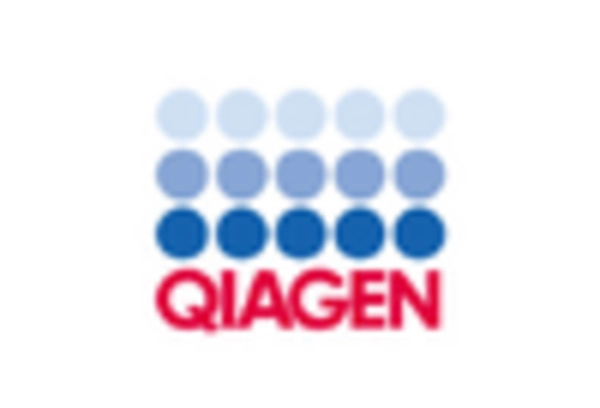Rising Healthcare Expenditure
Rising healthcare expenditure in the US is a significant driver of the oral cancer-diagnostics market. As healthcare budgets increase, there is a greater allocation of funds towards advanced diagnostic technologies and cancer care. This trend is evident in both public and private sectors, where investments in healthcare infrastructure are being prioritized. The increased spending allows for the procurement of state-of-the-art diagnostic equipment and the implementation of comprehensive screening programs. Consequently, the oral cancer-diagnostics market is likely to experience growth as healthcare providers enhance their diagnostic capabilities. Furthermore, as insurance coverage expands to include more diagnostic services, patient access to these technologies improves, further stimulating market demand.
Rising Incidence of Oral Cancer
The increasing incidence of oral cancer in the US is a primary driver for the oral cancer-diagnostics market. According to the American Cancer Society, approximately 54,540 new cases of oral cavity and oropharyngeal cancers are expected in 2025. This alarming trend necessitates the development and adoption of advanced diagnostic tools to facilitate early detection and improve patient outcomes. As awareness of the disease grows, healthcare providers are more inclined to invest in innovative diagnostic technologies. The rising incidence is likely to propel the demand for effective diagnostic solutions, thereby expanding the oral cancer-diagnostics market. Furthermore, the aging population, which is more susceptible to oral cancers, contributes to this upward trend, indicating a sustained need for enhanced diagnostic capabilities.
Government Initiatives and Funding
Government initiatives and funding programs are pivotal in advancing the oral cancer-diagnostics market. Federal and state governments are increasingly recognizing the importance of early detection in reducing oral cancer mortality rates. As a result, various funding initiatives have been established to support research and development in diagnostic technologies. For instance, the National Institutes of Health (NIH) allocates substantial resources to cancer research, which includes the development of novel diagnostic methods. This financial backing not only fosters innovation but also encourages collaboration between academic institutions and industry players. Consequently, the oral cancer-diagnostics market is likely to benefit from enhanced research capabilities and the introduction of cutting-edge diagnostic solutions, ultimately improving patient care.
Growing Demand for Preventive Healthcare
The growing demand for preventive healthcare is significantly influencing the oral cancer-diagnostics market. As patients become more proactive about their health, there is an increasing emphasis on regular screenings and early detection of oral cancers. This shift in patient behavior is prompting healthcare providers to offer more comprehensive diagnostic services. Additionally, public health campaigns aimed at educating individuals about the risks associated with oral cancer are contributing to this trend. The oral cancer-diagnostics market is expected to expand as more individuals seek preventive care, leading to higher screening rates and increased utilization of diagnostic tools. This proactive approach not only aids in early detection but also aligns with broader healthcare trends focused on improving overall health outcomes.
Technological Innovations in Diagnostic Tools
Technological innovations play a crucial role in shaping the oral cancer-diagnostics market. The introduction of advanced imaging techniques, such as fluorescence and optical coherence tomography, has significantly improved the accuracy of oral cancer detection. These technologies enable healthcare professionals to identify lesions at earlier stages, which is vital for effective treatment. Moreover, the integration of artificial intelligence in diagnostic processes is enhancing the efficiency and precision of oral cancer diagnostics. As these technologies become more accessible, healthcare facilities are likely to adopt them, driving market growth. The oral cancer-diagnostics market is expected to witness a surge in demand for these innovative tools, as they offer improved patient outcomes and align with the trend towards personalized medicine.

















Leave a Comment